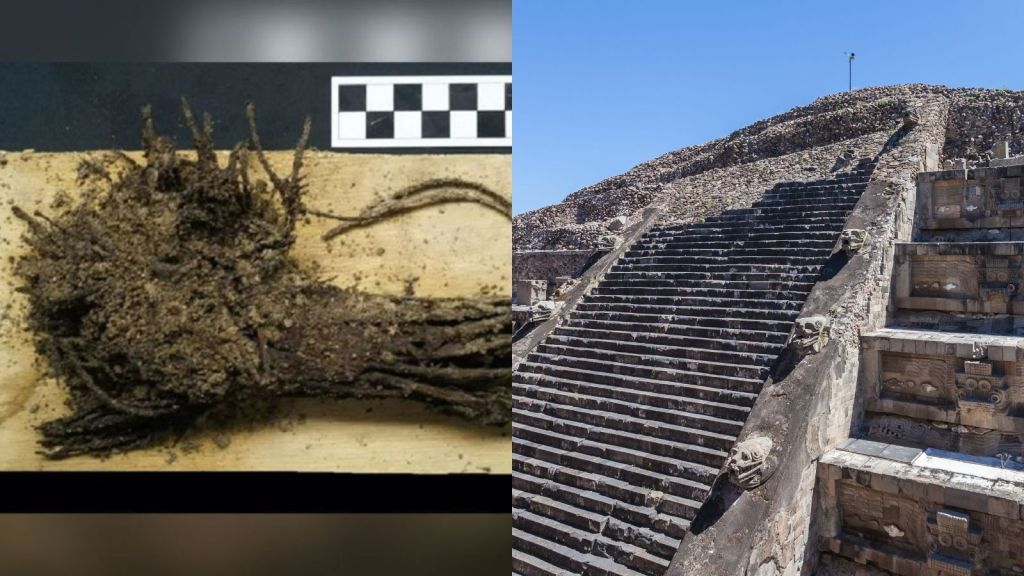This article originally appeared on Motherboard
The ancient Temple of Kukulkan, dedicated to its namesake—the feathered serpent god K’uk’ulkan, or Quetzalcoatl—has been slowly revealing its secrets for more than a century.
Videos by VICE
During excavations in the 1930s, a second, hidden pyramid containing an embellished red jaguar-shaped throne was discovered inside of the structure. Years later, in 2015, it was revealed that an enormous underground cavern, or “cenote,” lead to a subterranean river system beneath Kukulkan, and possibly held sacred significance to the early Mayans who worshipped there.

Now, archaeologists believe they’ve found the temple’s original structure: another smaller pyramid “encapsulated underneath the visible temple” that was built somewhere between 500 and 800 CE, according to the Associated Press.
This third pyramid could represent the “pure Maya” style, which bears no stylistic influence from outside civilizations, such as the Toltec peoples who originated from modern Hidalgo, Mexico, and are said to have conquered the city of Chich’en Itza.
“If this could be investigated in the future, this structure would be significant because it would speak to the first few periods of habitation of the site and would provide information about how the settlement developed,” archaeologist Denisse Lorenia Argote told CNN.
“With the discovery of this structure we’re talking about something from the pure Mayans. A lot has been excavated, and there is a lot of information on the transitional periods [of the Mayas] and there is a Mexican style at the site, but there is little information on the original site,” Argote added.
Researchers identified the 33-foot by 66-foot-tall structure using tri-dimensional electric resistivity tomography (ERT-3D), a 3D surveying technique that allows archaeologists to illuminate areas below the surface. The same imaging technique was also used to investigate buried tunnel chambers at Kukulkan that lay concealed within its limestone features.

The team of scientists confirmed the existence of a small ramp or stairway, along with portions of a religious altar. According to Rene Chavez Segura, a scientist at the National Autonomous University of Mexico, this new structure is close to the underground cenote, which could mean that Mayans purposefully built around the cavern. Separate excavations at Chich’en Itza have uncovered human bones, likely the victims of ritualistic sacrifice, that had been ceremonially tossed into the cenote.
However, not everyone buys into the theory that this discovery is a new one. Geoffrey Braswell, an anthropology professor at the University of California, San Diego who was not involved with the project, suspects the structure was actually found in the 1940s, when an archaeologist supposedly hit a third layer of the pyramid while digging near the second formation.
Braswell compared Kukulkan’s layout to that of a Russian nesting doll, with several smaller compartments “rattling around inside the same shell.”
“The tunnel was unstable, so we know very little about this platform. It appears to be much smaller than the outer two pyramids, and is not perfectly aligned within them,” Braswell added.
Nestled in plain sight in Mexico’s Yucatán Peninsula, Kukulkan is one of several monuments that still stand at the Mayan complex of Chich’en Itza. It was likely founded sometime around the 6th century, with Toltec invaders later constructing the visible portion of Kukulkan, which was given the alternate name, “El Castillo,” by Spanish Conquistadors.

The Temple of Kukulkan is nearly 100-feet-tall, and boasts 91 steps on each of its four faces. Legend has it that Quetzalcoatl returns to Earth twice a year before making its passage into the underworld. A precise knowledge of time and mathematics went into the pyramid’s construction, and it’s said to be a manifestation of the 365-day Mayan Calendar. For the two days when Quetzalcoatl is present in Chich’en Itza, shadows of a giant serpent can be seen descending the corners of the temple.
For 1,000 years, a diverse lineage of Mesoamerican peoples lived, worshipped, and built a mind-bending array of architectural masterpieces within the urban center. Chich’en Itza has since been designated as a UNESCO World Heritage Site, and sees an estimated 1.4 million tourists every year.


